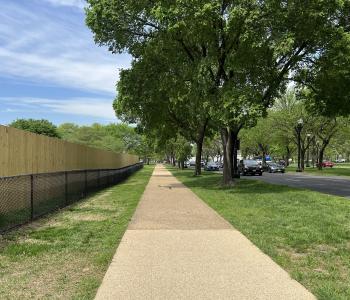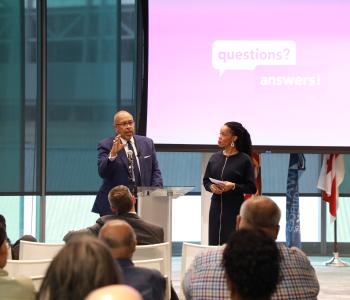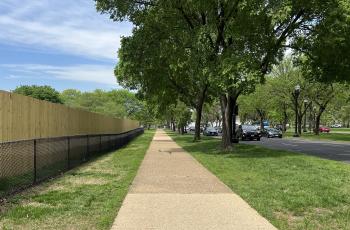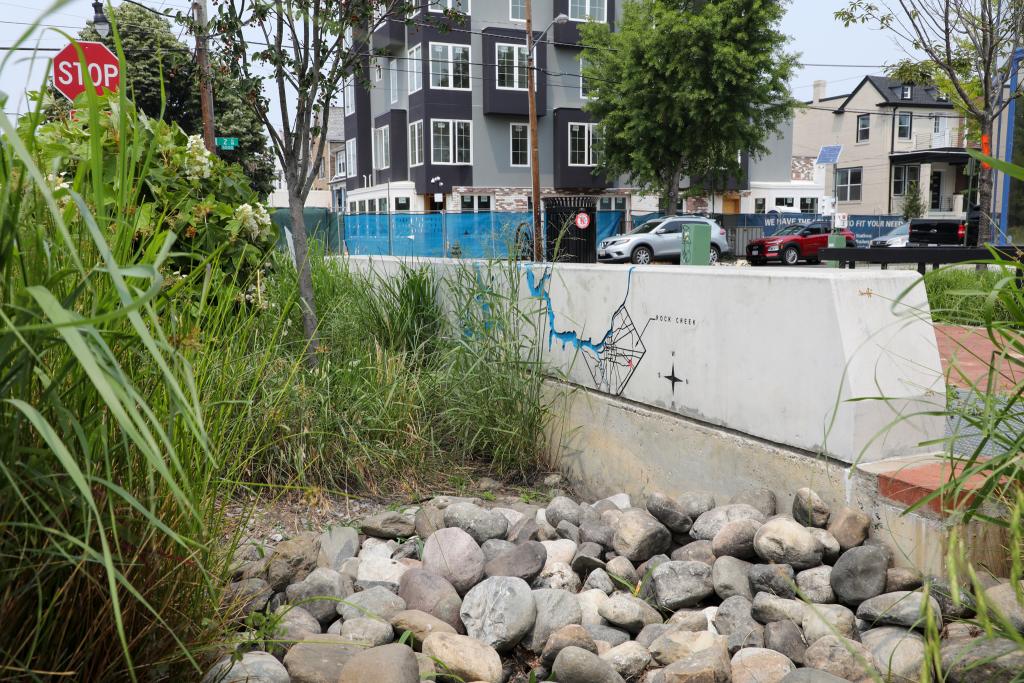District of Columbia Water and Sewer Authority Releases Final Long Term Control Plan for Combined Sewer System
Washington, D.C.—The District of Columbia Water and Sewer Authority’s (WASA) Board of Directors today announced their acceptance of a $1.265 billion recommended plan for controlling Combined Sewer Overflows (CSOs). The final Long Term Control Plan (LTCP) will reduce discharges from CSOs by an estimated 96 percent District-wide. CSOs are the discharge of storm water and wastewater caused by heavy rainfall conditions.
While all three of the District of Columbia’s receiving waterways—the Potomac River, Rock Creek, and the Anacostia River—will benefit, the Anacostia River will see the most significant reduction of CSOs.
District of Columbia Mayor, Anthony A. Williams, said now is the time to get this plan in action. "A top priority of my Administration is to restore the Anacostia – currently one of the nation’s most polluted rivers – to the precious natural resource that is should be for our community. Williams added, "We have worked diligently with WASA, our Department of Health and the federal EPA to develop this plan. I believe it is sensible, achievable and appropriate. We all share the goal of making the Anacostia fishable and swimmable once again. Now the time has come for action."
WASA’s Board Chairman, Glenn S. Gerstell shares the Mayor’s vision, "I am pleased that the final plan reduces overflows in the Anacostia by 98 percent. The Board and management have demonstrated its commitment to being a steward of the environment by its long and deliberative planning so that the Long Term Control Plan is a major contributor to the revitalization of the Anacostia River."
In June 2001, WASA submitted a draft LTCP to regulatory agencies and the public for review and comment. An extensive public outreach and comment period followed in the summer and fall of 2001, which included public meetings, significant input from the Stakeholder Advisory Panel (composed of many environmental organizations), and an elaborate public information process. Over 2,300 comments were received during the public comment period.
"This process was truly a community-wide effort," Gerstell added. "The many public comments received were extremely valuable as we worked to finalize the Long Term Control Plan. The end result is a plan that provides significant improvement in the quality of each receiving waterway, while at the same time balancing the affordability to ratepayers."
The plan is scheduled to be submitted to the Environmental Protection Agency and the District of Columbia’s Department of Health for review and approval at the end of July.
WASA’s General Manager, Jerry N. Johnson added, "We have worked hard to meet all regulatory requirements and to listen, to understand and to respond to the concerns of organizations and individuals who have a stake in the revitalization of our regional waterways." Johnson also said, "Not everyone will agree, but I believe there is ample evidence that the Long Term Control Plan, approved by the Board of Directors this morning, is among the best ever developed for submission to the USEPA by any jurisdiction. We also are grateful to EPA for providing the funding for the plan development. " Johnson also said it’s important to note that the Plan will significantly improve the quality of life in certain neighborhoods by relieving some local flooding when heavy rain occurs.
Cause of CSOs
Like many older cities in the U.S., the District of Columbia’s sewer system is comprised of both combined sewers, those that carry both wastewater and runoff from storms, and separate sanitary sewers. Combined sewers serve about one-third of the District. Most of them are located in older developed sections of the District. During dry weather conditions, sewage flowing through the combined sewer system is conveyed to the District of Columbia’s Advanced Wastewater Treatment Plant at Blue Plains where the wastewater is treated to remove pollutants before discharge into the Potomac River. When the capacity of a combined sewer is exceeded during major storms, the excess flow is discharged from up to 59 CSO outfalls to the Anacostia and Potomac Rivers, Rock Creek and tributary waters. Discharges of CSOs can adversely impact the receiving water’s quality. The primary purpose of the LTCP is to control CSO discharges to our waterways so that water quality in the receiving waters is improved.
The LTCP shows that water quality is also affected by sources other than CSOs. For example, storm water, pollutants from upstream, and sediments in the bottom of the Anacostia River, all have an impact. Therefore, reducing CSOs will not entirely solve the pollution problem in the District’s waterways or make the Anacostia River swimable and fishable. While the LTCP is only required to address CSOs, WASA has considered the other sources to identify their impact on the receiving waters. This will assist in developing a watershed-based approach to improving water quality.
Existing Conditions
Over the years, WASA has made progress in reducing CSOs through a variety of improvements made to the combined sewer system. In the late 1980s, a treatment facility was constructed near RFK Stadium and other improvements were made to reduce CSOs. However, there continues to be a large number of overflow events annually. In an average year, there are about 82 overflows events in the Anacostia River; 75 in the Potomac River, and 30 in Rock Creek.
In order to most effectively address the CSO problem, WASA considered and evaluated a number of technological approaches that might help reduce overflow events to between zero and 12 per year, following EPA guidelines.
Recommended Plan
The recommended final Long Term Control Plan will meet or surpass EPA requirements for both the average number of overflow events yearly and the percentage of combined sewage that is captured for treatment in the combined sewer system. Under the recommended plan, average CSO overflow volume would be reduced by 96 percent (up from 92 percent in the Draft LTCP) and
overflow events would be reduced to two a year in the Anacostia River, four a year on the Potomac River and Rock Creek, and one a year at Piney Branch. This is a significant improvement over the Draft LTCP (see Table 1 in the press release link below).
The final LTCP consists of many elements and program components. Under the plan, an estimated $940 million would be allocated for improvements in the Anacostia area CSO system. An additional $50 million would be spent on improvements for Rock Creek and $250 million for the Potomac
River. Additional amounts will be spent for related CSO improvements at the Blue Plains Advanced Wastewater Treatment Plant, and for low impact development (LID) projects in WASA facilities.
WASA is also committed, as part of the LTCP, to partnering with the EPA and others to conduct specific research on the long-term impacts and effectiveness of LID initiatives.
It is envisioned that this research effort will generate a substantive body of data that could be used to establish specific standards for LID applications. With these standards, EPA could provide guidance for certain allowances for various types of LID applications. This would then let us look at and reevaluate the use of more LID with an understanding of its benefits and how they are measured and applied within our combined sewer system.
Schedule of Completion
In accordance with public comments, the schedule for implementing the recommended control plan was developed by giving priority to projects that benefit the Anacostia River. The projects in the LTCP can be divided into two categories: those in the existing Capital Improvement Program (CIP) and those not currently in the CIP. Projects in the CIP have been budgeted and scheduled and these projects will move forward while the LTCP is going through the approval process. For projects not currently in the CIP, an implementation schedule has been predicated on approval of the LTCP. Based on the financial capability assessment and in order to mitigate the annual rate increases that would be required to fund the full LTCP, a 40-year implementation time is proposed for the entire recommended plan if no assistance from the federal government is received. If significant federal assistance is obtained, it is technically feasible to accelerate the schedule to a 15-year implementation time frame. Significant Federal assistance on the order of 62 percent would be required to achieve this schedule.
Financial Impact of Implementation of the Final LTCP
Financing CSO control programs equitably without placing an unreasonable burden on ratepayers is challenging. A detailed affordability analysis using procedures developed by the EPA was performed to assess the impact of CSO control costs on District ratepayers and on the fiscal health of the community. Costs were calculated on the basis of both a household with the area’s median income, estimated at $39,760 per year in 2001, and the 20th percentile household income of $18,000 per year in 2001.
The analysis was performed using existing conditions, WASA’s current capital improvement program, and the capital improvement program coupled with the recommended CSO controls. Additional analysis was made assuming varying levels of federal financial assistance ranging from 0 percent to 75 percent of the CSO control program costs (see Table 2 in the press release link below).






